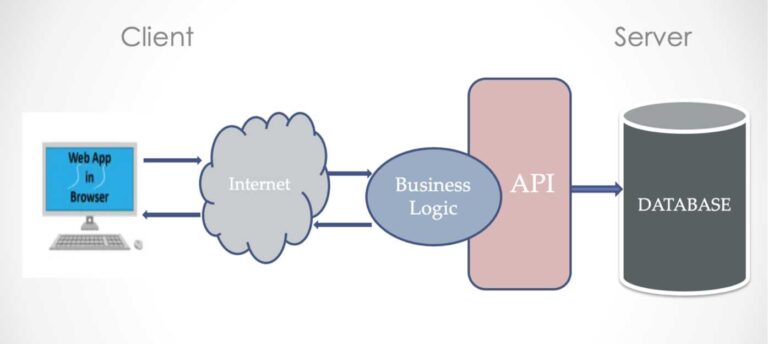API Testing
API Testing Definition
Tools used for API Testing
API Testing types
Benefits of API Testing
Bug & Defects detects by API Testing
Web Service Definition
Types of WebServices
Web Services Components
WebServices Architecture
Difference b/w Web services & API
What is SOAP webService
SOAP Message Structure
API Testing Tutorial- Definitions, Benefits ,Tool and Types
This article will present you with a complete idea about Introduction of API ,API testing , how to start API testing and API testing types.

What is API?
-
- An API (Application Programming Interface) is a software that enables two applications to communicate with each other.
- APIs are a set of functions and procedures that allow for the creation of applications that access data and features of other applications, services, or operating systems.
- API is a type of software interface which offered a service to other pieces of software.
- A document or standard that describes how to build or use such a connection or interface is called an API specification
- Examples of APIs are Google Maps API , Amazon Advertising API , Twitter API , You tube API etc.
So In real World if we take an example of API , during online flight ticket booking , We usually open website , enter information ,name , address , payment details etc and book the ticket but in background there are a lot of APIs interact with each other and they are collaborating behind the scenes with other applications and provide you the booking confirmation.

What is API Testing?
API testing is a kind of software testing which determines if the developed APIs meet expectations regarding the functionality , reliability , performance and security of the application
API testing is now considered a critical part of automation testing as it now serves as the primary interface to application logic and because UI tests are difficult to maintain with the short release cycles and frequent changes commonly used with Agile software development and DevOps.
What are the tools used for API testing?
What are the API testing Types?
API testing typically involves the following practices
-
- Unit Testing
- Functional Testing
- Load Testing
- Security testing
- Web UI Testing
- Interoperability Testing (SOAP Only)
- WS-* compliance testing (SOAP Only)
- Penetration Testing
- Fuzz-testing
Unit Testing
-
- It is a level of the software testing process where individual components of a system are tested. Objective is to validate that each unit of the software performs as designed.
- The main concept of this test is to sequester a written code that determines if it’s working at the optimum level. It helps to identify flaws in the early stages for better functionality in the long term.
Functional Testing-
-
- Functional testing is a software testing technique that tests features and functionality of the Software under test, by providing inputs and evaluating outputs.
- The main objective for performing functional testing is to make sure the API functions are handled well within the planned parameters.
Load Testing:
-
- Load testing is performed to determine a system’s behaviour under both normal and at peak conditions.
- It helps to identify the maximum operating capacity of an application as well as any bottlenecks and determine which element is causing degradation.
- This is to ensure that the API’s do not contain memory leaks or other similar defects that might cause issues after running for a prolonged period of time.
Security testing:
-
- It is a process to determine that an information system protects data and maintains functionality.
- Validate whether there is any information leakage in the software
- It prevent unauthorised access to the resources and data
- It ensures the API implementation is secure from external threats.
Web UI Testing
-
- UI testing focuses more on the interface which ties into the API rather than the API testing itself.
- This is performed as part of a larger-scale integration test that also involves APIs.
Interoperability Testing (SOAP Only) :
-
- Interoperability Testing is a type of testing that is performed to examine software’s interaction either with its components or other software.
- By conforming to these guidelines and utilizing these tests, interoperability between SOAP APIs can be confirmed and supported.
WS-* compliance testing (SOAP Only)
-
- WS-* compliance is tested to ensure standards such as WS-Addressing, WS-Discovery, WS-Federation, WS-Policy, WS-Security, and WS-Trust are properly implemented and utilized.
Penetration Testing:
-
- A penetration test, also known as a pen test, is a simulated cyber-attack against your computer system to check for exploitable vulnerabilities.
- It is a security exercise where a cyber-security expert attempts to find and exploit vulnerabilities in a computer system
Fuzz-testing
-
- Fuzz testing is an automated software testing technique that attempts to find hackable software bugs by randomly feeding invalid and unexpected inputs and data into a computer program in order to find coding errors and security loopholes.
- This technique tests the API’s limits to prepare for the “worst-case scenarios.”
What are the benefits of APITesting?
API testing is an extremely important type of testing. It significance is immense as API testing not only ensures the quality, functionality, effectiveness, and performance of the software and application, but also validates its reliability and security. Below are few important benefits of API testing
-
- Test for core functionalities:The major core advantage of API testing is that it provides access to applications without users actually having to interact with a potentially disparate system. This helps the tester to detect and recognise the errors early, instead of them becoming larger issues during GUI testing
- Time effectiveness:API testing is less time-consuming than GUI testing. With API testing, executing a regression test suite takes very less time; while the same scenario under GUI testing takes 4-5 times compare to API test execution.
- Easy GUI integration: APIs can be tested without a user interface to check the application’s core functionality and to find errors and bugs.
- Reduce cost of testing: Testing APIs helps you to find small bugs in the core functions before being tested in the GUI. These small bugs can potentially become big problems during GUI testing, so if you can find and fix bugs during API testing it saves you time and money
- Language-independent:In API testing, all data is converted to JSON or XML for transfer over the internet. This also means that any language can be used for automation, independent from the languages used to develop the application.
Types of Bugs & Defects that API testing defects
Types of bugs found in API testing
-
- Duplicate or missing functionality
- Improper messaging
- Identifies configuration errors on all devices:
- Identifies bugs related to accessibility:
- Multi-threaded issues
- Security, performance & security issues
- Reliability issues
